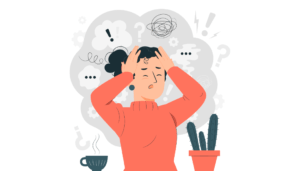Generalized Anxiety Disorder (GAD) is a common mental health condition that affects millions of people worldwide. GAD is characterized by persistent, excessive, and unrealistic worry about everyday situations and events, which can cause significant distress and impairment in daily functioning. Fortunately, with proper diagnosis and treatment, people with GAD can learn to manage their symptoms and improve their quality of life. In this article, we will explore the key aspects of GAD psychiatry, including its symptoms, causes, diagnosis, and treatment options.
Contents
Understanding GAD: Symptoms and Diagnosis

- Excessive worrying about various topics, such as health, finances, work, or relationships, lasts for months.
- Feeling restless, on edge, or keyed up.
- Fatigue or trouble sleeping due to worry.
- Difficulty concentrating or mind going blank.
- Muscle tension, aches, or soreness.
- Irritability, edginess, or jumpiness.
- Avoidance of activities or situations that trigger anxiety.
Diagnosing GAD involves a thorough clinical evaluation by a mental health professional. The criteria for GAD diagnosis include excessive worry and anxiety for more days than not for at least six months, along with the presence of at least three or more of the above-mentioned symptoms.
In addition to clinical evaluation, various tools, and assessments can be used to diagnose GAD, such as anxiety scales and questionnaires. These assessments can help clinicians to better understand the severity and type of symptoms and to monitor treatment progress over time.
Causes of GAD: Genetics, Environment, and Brain Chemistry
The causes of Generalized Anxiety Disorder (GAD) are complex and not fully understood. Likely, a combination of genetic, environmental, and brain chemistry factors contribute to the development of GAD.
- Genetics: GAD tends to run in families, suggesting a genetic component. Studies have shown that individuals with a family history of anxiety disorders are at increased risk of developing GAD. Additionally, specific genes may contribute to the development of GAD.
- Environment: Traumatic or stressful life events, such as abuse, neglect, or significant life changes, can increase the risk of developing GAD. Chronic stress or ongoing exposure to stressors can also increase the risk of GAD. Additionally, environmental factors such as substance abuse, social isolation, or chronic medical conditions can contribute to the development of GAD.
- Brain Chemistry: GAD has been linked to imbalances in certain neurotransmitters in the brain, particularly serotonin, norepinephrine, and gamma-aminobutyric acid (GABA). These neurotransmitters play a key role in regulating mood, anxiety, and stress response.
Treatment Options for GAD
The most effective treatment approach for GAD usually involves a combination of medication, therapy, and lifestyle changes.
- Medications: Antidepressants, such as selective serotonin reuptake inhibitors (SSRIs) and serotonin-norepinephrine reuptake inhibitors (SNRIs), are commonly used to treat GAD. These medications can help to reduce anxiety and improve mood. Benzodiazepines may also be prescribed, but these drugs can be habit-forming and are typically only used for short-term treatment.
- Therapy: Cognitive-behavioral therapy (CBT) is an evidence-based psychotherapy that is often used to treat GAD. CBT helps individuals to identify and change negative thinking patterns and behaviors that contribute to anxiety. Other types of therapy, such as acceptance and commitment therapy (ACT) and mindfulness-based therapies, may also be effective in treating GAD.
- Lifestyle Changes: Certain lifestyle changes can help to reduce anxiety and improve overall mental health. Regular exercise, a healthy diet, good sleep hygiene, stress management techniques such as relaxation exercises, meditation or breathing techniques, and avoiding or limiting caffeine, nicotine, and alcohol can all be helpful.
- Complementary and Alternative Approaches: Some individuals may also benefit from complementary and alternative treatments, such as herbal supplements, acupuncture, or massage therapy. It is important to discuss any complementary or alternative approaches with a healthcare professional before trying them, as some may interact with medications or be unsafe for certain individuals.
The Future of GAD Psychiatry: Advances in Treatment and Research

Here are some of the advances in GAD psychiatry that could shape the future of GAD treatment:
- Personalized Medicine: Advances in genetics and neuroimaging are providing new insights into the mechanisms underlying GAD. This knowledge could lead to personalized treatments that are tailored to an individual’s unique neurobiological profile.
- Virtual Reality Therapy: Virtual reality therapy (VRT) is an emerging treatment approach that could be particularly helpful for individuals with GAD. VRT involves exposing individuals to anxiety-provoking situations in a safe and controlled environment, allowing them to learn coping skills and reduce their anxiety in real-life situations.
- Neurofeedback: Neurofeedback is a type of biofeedback that involves training individuals to control their brainwaves using real-time feedback. Neurofeedback has shown promise as a treatment for GAD, helping individuals to regulate their anxiety levels and improve their overall mental health.
- Digital Therapeutics: With the growth of technology, digital therapeutics, such as mobile apps or online therapy, are becoming increasingly popular. These digital tools have the potential to provide accessible and effective treatment options for individuals with GAD.
- Transcranial Magnetic Stimulation (TMS): Transcranial Magnetic Stimulation is a non-invasive brain stimulation technique that uses magnetic fields to stimulate nerve cells in the brain. TMS has shown promise as a treatment for depression, and ongoing research is exploring its potential as a treatment for anxiety disorders, including GAD.
GAD and Other Mental Health Conditions: Comorbidity and Differential Diagnosis

Generalized Anxiety Disorder (GAD) is a common mental health condition that often co-occurs with other mental health conditions. Comorbidity, or the co-occurrence of two or more disorders, is common in individuals with GAD. Additionally, some symptoms of GAD may overlap with symptoms of other mental health conditions, making it important to consider differential diagnosis when assessing for GAD.
Comorbidity with Other Mental Health Conditions
- Depression: GAD is often co-occurring with depression. The symptoms of GAD and depression, such as fatigue, difficulty sleeping, and loss of interest in activities, can overlap.
- Panic Disorder: Panic disorder means sudden and intense panic attacks, which may cause individuals to avoid certain situations or activities. Some individuals with GAD may also experience panic attacks, making it important to differentiate between the two conditions.
- Obsessive-Compulsive Disorder (OCD): GAD can co-occur with OCD, as individuals with GAD may experience excessive worry or anxiety about their obsessions or compulsions.
Differential Diagnosis
- Social Anxiety Disorder: Social anxiety disorder means intense fear or anxiety in social situations. While individuals with GAD may experience anxiety in social situations, social anxiety disorder typically involves more specific fears or phobias related to social situations.
- Post-Traumatic Stress Disorder (PTSD): PTSD is a mental health condition that can develop after experiencing or witnessing a traumatic event. While individuals with GAD may experience anxiety related to traumatic events, PTSD involves a more specific set of symptoms, such as flashbacks or nightmares.
- Specific Phobias: Specific phobias involve intense and irrational fears of specific objects or situations. While individuals with GAD may experience anxiety related to specific objects or situations, the fear is often more generalized.
Conclusion
Generalized Anxiety Disorder (GAD) is a common and often debilitating mental health condition that can significantly impact an individual’s daily life. However, with proper diagnosis and treatment, individuals with GAD can learn to manage their symptoms and improve their quality of life.
It is also important to consider comorbidity with other mental health conditions and differential diagnosis when assessing for GAD, as these factors can impact the accuracy of diagnosis and treatment. Mental health professionals can use various tools and assessments to develop an individualized treatment plan for each individual with GAD.
For more information, please contact MantraCare. A psychiatrist is a medical doctor who specializes in the diagnosis, treatment, and prevention of mental illnesses and emotional disorders. If you have any queries regarding Online Counseling experienced therapists at MantraCare can help: Book a trial therapy session


